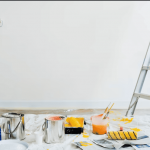When it comes to exterior painting, attention to detail is crucial to achieving a polished and professional finish. One area that often requires special attention is the cornice, which adds architectural beauty to the exterior of a house. Properly painting the cornice enhances the aesthetic appeal and protects it from weathering and deterioration. In this expert guide, we will walk you through the process of painting a cornice, providing valuable tips and insights for a flawless finish. If you’re in need of professional exterior painters, our house painters in Hobart are ready to assist you.
Materials and Supplies You Need to Paint Cornice
To paint the cornice effectively, you will need the following materials and supplies:
- Paint: Choose a high-quality exterior paint specifically designed for the type of surface you’re working with. Opt for paint with good durability and weather resistance to ensure longevity.
- Primer: Applying a primer is essential, especially if you’re painting over bare wood or previously painted surfaces. It helps improve paint adhesion and provides a uniform surface to adhere to.
- Brushes and Rollers: Invest in good-quality paint brushes and rollers that are suitable for the size of the cornice. Use a brush for detailed work and a roller for larger areas.
- Drop Cloths: Using plastic sheets, protect the surrounding areas from paint splatters and spills. This will prevent any damage to the ground or other surfaces.
- Painter’s Tape: This tape helps to achieve a professional finish and avoids accidentally painting adjacent surfaces.
- Sandpaper: If the cornice has rough or uneven spots, use sandpaper to smooth them before painting. This will ensure a seamless and even application of paint.
Steps on How to Paint Cornice: Tips From Expert Exterior Painters
- Check your Cornice for Signs of Damage: Before starting the painting process, inspect the cornice for any signs of damage, such as cracks, peeling paint, or rot. If any issues are detected, make the necessary repairs. It is best to consult experienced exterior painting contractors to address them.
- Tape Off the Edges: Use painter’s tape to carefully mask off the edges of the cornice, including any adjacent surfaces you don’t want to paint. This step will help create clean lines and prevent accidental paint smudges.
- Prime the Surface: Apply a coat of primer to the cornice, ensuring that it covers the entire surface evenly. Priming helps the paint adhere better and provides a consistent base for the topcoat.
- Paint the Cornice: Once the primer is dry, it’s time to apply the paint. Use a brush for intricate areas and a roller for larger sections. Start from the top and work your way down, using smooth and even strokes. Apply multiple thin coats, allowing sufficient drying time between each coat.
- Inspect Your Work: After the final coat of paint has dried, carefully inspect the cornice for imperfections or missed spots. Touch up as needed to achieve a flawless finish. Remove the painter’s tape once the paint is completely dry.
Mistakes You Must Avoid
- Rushing the Preparation: Proper preparation is key to a long-lasting paint job. Avoid skipping or rushing through the preparation steps, such as cleaning, sanding, and priming. Adequate preparation ensures the paint adheres well and provides a smooth and durable finish.
- Neglecting Safety Precautions: When working on exterior painting projects, it’s important to prioritise safety. Use appropriate personal protective equipment (PPE) such as gloves, goggles, and masks to protect yourself from paint fumes, dust, and any potential hazards.
- Applying Thick Coats of Paint: Thick coats of paint may seem like a time-saving solution, but they can lead to drips, uneven coverage, and longer drying times. Instead, apply multiple thin coats, allowing each coat to dry completely before applying the next. This will result in a more even and professional-looking finish.
- Overlooking Weather Conditions: Painting the cornice should be done in favourable weather conditions. Avoid painting on extremely hot or cold days, as it can affect the paint’s ability to adhere and dry properly. Additionally, avoid painting in direct sunlight, as it can cause the paint to dry too quickly and lead to visible brush or roller marks.
Exterior Painters’ Advice: Things You Must Follow
- Choose the Right Paint: Selecting a high-quality exterior paint that is specifically formulated for the type of surface and weather conditions in Hobart is essential. Consult with your local paint supplier or professional exterior painters in Hobart to ensure you make the right choice.
- Use Proper Painting Techniques: When painting the cornice, use smooth and consistent strokes with the brush or roller. Work from top to bottom, following the natural lines of the cornice. This technique helps to achieve an even application of paint and minimises visible brush or roller marks.
- Allow Sufficient Drying Time: Patience is key when it comes to drying times. Follow the manufacturer’s instructions for drying times between coats and the final cure. Rushing the drying process can compromise the integrity of the paint job.
Why Homeowners Choose to Paint the Exterior Cornice
Enhancing Curb Appeal
Painting the exterior cornice is a popular choice among homeowners because it significantly enhances the curb appeal of their homes. A fresh coat of paint can revitalise the appearance of the cornice, making it stand out and adding charm and character to the overall exterior design.
Protection Against Weathering
The cornice is exposed to the elements, making it vulnerable to weathering, such as sun damage, moisture, and temperature fluctuations. Painting the cornice provides a protective barrier against these elements, preventing premature deterioration and extending its lifespan.
Maintenance and Longevity
Regularly painting the exterior cornice is part of a proactive maintenance plan for homeowners. It helps to prevent issues like rotting, cracking, or peeling, which can be more costly to repair in the long run. Homeowners can ensure the longevity of the cornices and structural integrity by hiring professional exterior painters in Hobart.
Personalisation and Style
Painting the cornice allows homeowners to express their personal style and customise the look of their homes. With a wide range of paint colours available, homeowners can choose a shade that complements their home’s exterior and reflects their aesthetic preferences.
Book a Free Consultation Now!
Frequently Asked Questions on Painting Exterior Cornice
As professional house painters in Hobart, Australia, we come across several frequently asked questions regarding painting exterior cornices. Here are some of the most common queries and their answers:
1. Do you paint cornices with ceiling or wall paint?
We recommend painting cornices with specialised or trim paint rather than ceiling or wall paint. Cornice paint is designed to have better adhesion, durability, and flexibility, ensuring a long-lasting finish on the cornice. It also offers better coverage and is formulated to handle the unique demands of exterior surfaces.
2. What colour should I paint my cornice?
The choice of colour for your cornice largely depends on personal preference and the overall aesthetic of your home’s exterior. Many homeowners prefer to paint the cornice in a colour that matches or complements the colour of the house’s trim or fascia. It’s always a good idea to consult with reliable exterior painters to help you choose a colour that enhances the overall look of your home.
3. Do you paint the cornice or wall first?
The general rule of thumb is to paint the cornice before painting the walls. This ensures that any drips or accidental paint smudges on the walls can be easily covered when painting the walls afterwards. Painting the cornice first also allows for better precision and avoids potential damage to the fresh paint on the cornice when painting the adjacent walls.
4. What is the best coving paintbrush?
Using a brush specifically designed for trim work is best when painting cornices. A good-quality angled brush with synthetic bristles is best. The angled shape helps with precise application and reaching into tight corners, while synthetic bristles provide smooth and even coverage.
5. Is DIY painting a possible option to paint the exterior cornice?
While DIY painting can be an option for some homeowners, it’s important to consider the complexity and challenges associated with painting exterior cornices. Cornices often require specialised techniques and tools to achieve a professional finish. Additionally, working at heights and dealing with weather conditions can pose safety risks. It is wise to hire experienced exterior painters to ensure high-quality results, save time, effort, and money on resources, and provide peace of mind.
Count on Our Painters in Hobart for All Painting Needs
Ready to give your home’s exterior a stunning makeover? Dyson Painters in Hobart is here to help you. With our expert cornice painting services, we can enhance the beauty and protection of your home’s architectural features.
Don’t settle for a dull and worn-out cornice when you can have a fresh and vibrant one that complements your home’s style. Our team of skilled exterior painters specialises in meticulous cornice painting, ensuring precise lines, even coverage, and a flawless finish.
Whether you need to paint a cornice or any other area in the interiors or exteriors of your house, our trained house painters in Hobart will provide the highest level of craftsmanship and attention to detail. We use top-quality paints, materials, and advanced techniques to deliver outstanding results that will transform your home’s exterior.
Contact us today to schedule a consultation and let our professional exterior painters in Hobart work their magic on your cornice. Trust our expertise to bring out the beauty of your home’s architectural details.
Also Read:
Why Exterior Painting Should Be on Your To-Do List This Summer
5 Easy Tips to Ensure Safe Exterior Painting
How To Identify And Fix Exterior Paint Problems?
Mastering the Art of Exterior Painting: Expert Tips and Techniques
How To Identify And Fix Exterior Paint Problems?





